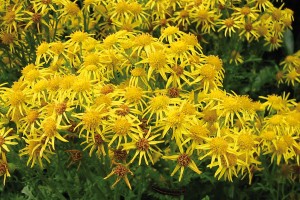Ragwort crown-boring moth
Image: ragwort crown-boring moth (Cochylis atricapitana).
History in New Zealand
The ragwort crown-boring moth is native to Europe and has established readily in Australia where it is being used as a biocontrol agent. The crown-boring moth was imported from Australia in 2005 by Manaaki Whenua – Landcare Research in conjunction with the West Coast Ragwort Control Trust because existing ragwort agents were not able to control ragwort in all situations. The moth is found over a wide range of climates in its native range. Releases were made in 2006 and 2007 but there is no evidence that the moth has established. No further efforts to release and establish the moth are planned.
How would I find/recognise it and what is its lifecycle?
The adult moths are brown with flecks of black and grey on a lighter background, which may have a pink tinge in females. The moths are about 8-10 mm long and have a small tuft of scales just behind the head. The moths are nocturnal and are particularly active at dawn and dusk, but you may see them resting on ragwort plants during the day.
Image: ragwort crown-boring moth.
Females lay eggs in spring and late summer and can lay several hundred each. You may see the tiny creamy-white eggs in the crown or on the underside of leaves close to veins, usually singly or in pairs.
Image: ragwort crown-boring moth eggs.
Caterpillars that hatch in spring mine into a leaf and then into the mid-vein, and work towards the stem.
Image: caterpillar and mines.
Older caterpillars mine up the stem or occasionally climb up it to feed on the developing shoots and flowers. Mining causes growing stems to thicken and the leaves to bunch.
Image: ragwort crown-boring moth caterpillars.
Image: caterpillar mining through the stem.
Caterpillars produced in autumn bore into the crown of rosettes, but not the roots. The small central leaves of attacked rosettes stop growing and a small amount of black frass will be present.
To see the caterpillars, you may need to pull apart damaged plants. The caterpillars are creamy-white, and they go through five growth stages before pupating. The pupae are yellowish-brown and about 7-8 mm long. The first generation pupates inside the plant and new adults later emerge to begin a second generation. In some years, a third generation (or more) may be produced. Caterpillars produced later in the season remain inside plants over winter and complete development and pupate in the soil in spring.
Ragwort crown-boring moths are easy to differentiate from other ragwort biocontrol agents or insects on ragwort.
See Ragwort plume moth, Ragwort flea beetle, Cinnabar moth.
Blue stem borer (Patagoniodes farinaria) larvae may also be found in stems and reach a similar size to plume moth larvae but they are a distinctive bluish colour. The maggots of a fly (Melanagromyza senecionella) may also be seen in the stems but are much smaller white grubs.
How does it damage ragwort?
The caterpillars are the damaging stage. Their mining thickens young stems and supresses flowering, and tends to kill older stems and the root crowns of rosette plants.
Will it attack other plants?
It is extremely unlikely that the moths will damage any plants other than ragwort (Jacobeae vulgaris).
How effective is it?
Because the moth has not yet established, there have been no studies to determine their effect on ragwort population dynamics in New Zealand. In Australia, a 40% reduction in the height (and seed production) of flowering plants and a significant reduction in both size and survival of rosettes has been recorded at one site 10 years after the moths were released. It may take 5-10 years before the impact of the moths becomes noticeable.
How can I get the most out of it?
The moths fly as little as 100 m or as much as several kilometres a year. If they establish here, dispersal may need to be accelerated by moving caterpillars to new areas.
How do I select a release site?
Read Guidelines for selecting release sites for biocontrol agents.
A suitable site would be at least 50 m x 50 m. Do not allow stock to eat the ragwort. If necessary, use temporary fencing.
How do I collect it for release at other sites?
Read Guidelines for collecting, relocating and releasing biocontrol agents.
The best time to do this would be in midsummer. Dig up damaged plants, roots and all, and put them in a chilly bin. Retain as much of the surrounding soil as possible as it may contain pupae. The more caterpillars and/ or pupae you can shift, the greater the chance they will establish, and we recommend shifting at least 50-100 plants. At the release site, place one or two infested plants beside a healthy ragwort plant so any caterpillars can crawl across. Do not overload plants.
How do I manage the release sites?
Do not spray, heavily graze or cultivate this area for at least 2 years to allow the moths to increase in numbers so they can be harvested for redistribution and begin to disperse.
